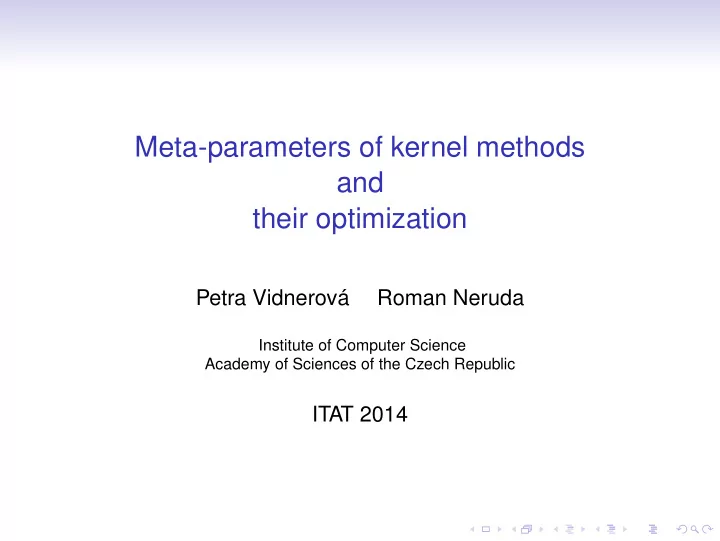

Meta-parameters of kernel methods and their optimization Petra Vidnerová Roman Neruda Institute of Computer Science Academy of Sciences of the Czech Republic ITAT 2014
Motivation Learning given set of data samples find underlying trend, description of data Supervised learning data – input-output patterns create model representing IO mapping classification, regression, prediction, etc.
Motivation Learning methods wide range of methods available statistical approaches neural networks (MLP , RBF networks, etc.) kernel methods (SVM, etc.) Learning steps data preprocessing, feature selection model selection parameter setup
Motivation Aim of this work some experience needed to achieve best results our ultimate goal - automatic setup model recomendation meta-parameters setup in this talk: meta-parameters setup for the family of kernel models Outline brief overview SVM, RN role of kernel function meta-parameters optimisation methods some experimental results
Kernel methods family of models, became famous with SVM learning schema 1. data is processed into a kernel matrix 2. learning algorithm applied using only the information in the kernel matrix resulting model - linear combination of kernel functions
Kernel methods - basic idea choose a mapping to some (high dimensional) dot-product space - feature space Φ : X → H work in feature space dot product in feature space given by kernel fucntion K ( · , · )
Support Vector Machine classification task input points are mapped to the feature space classification via separating hyperplane with maximal margin such hyperplane is determined by support vectors many implementations available, i.e. libSVM parameter setup includes: kernel function C trade-of between maximal margin and minimum training error
Regularization Networks approximation tasks, neural networks with one hidden layer x i , y i ) ∈ R d × R } N given { ( � i = 1 , recover the unknown function find f that minimizes H [ f ] = � N i = 1 ( f ( � x i ) − y i ) 2 generally ill-posed choose one solution according to a priori knowledge ( smoothness, etc. ) Regularization approach x i ) − y i ) 2 + γ Φ[ f ] add a stabiliser H [ f ] = � N i = 1 ( f ( �
Derivation of Regularization Network stabilizer based on fourier transform penalize functions that oscillate too much ˜ f Fourier transform of f s | ˜ ˜ f ( � s ) | 2 G positive function � R d d � Φ[ f ] = ˜ ˜ G ( � s ) → 0 for || s || → ∞ G ( � s ) 1 / ˜ G high-pass filter for a wide class of stabilizers the solution has a form N � w i G ( � x − � f ( x ) = x i ) , i = 1 where ( γ I + G ) � w = � y meta-parameters: G kernel function, γ
Role of Kernel Function Choice of Kernel Function choice of a stabilizer choice of a function space for learning (hypothesis space) geometry of the feature space represent our prior knowledge about the problem should be chosen according to the given problem Frequently used kernel functions linear K ( � x ,� y ) = � x T � y x T � y + r ) d , γ > 0 polynomialial ( � x ,� y ) = ( γ� radial basis function ( � x ,� y ) = exp ( − γ || � x − � y || 2 ) , γ > 0 x T � sigmoid ( � x ,� y ) = tanh ( γ� y + r )
Toy example - image approximation 10 − 5 10 − 4 10 − 3 10 − 2 0 . 0 0.5 1.0 1.5 2.0
Meta-parameters setup Parameters of kernel learning algorithms kernel function type additional kernel parameter(s) (i.e. width for Gaussian) regularization parameter γ
Search for optimal meta-parameters minimization of cross-validation error winning parameters used for training on the whole data set Grid search extensive search, various couples of parameters tried time consuming start with coarse grid, than make finer quite standard way, implemented for example in libSVM
Search for optimal meta-parameters Genetic algorithm robust optimisation technique often used in combination with learning algorithms or NNs individuals coding kernel function, its parameters, regularization parameter I = { K , p , γ } Simulated annealing stochastic optimisation method search least number of evaluations
Thank you! Questions?
Recommend
More recommend